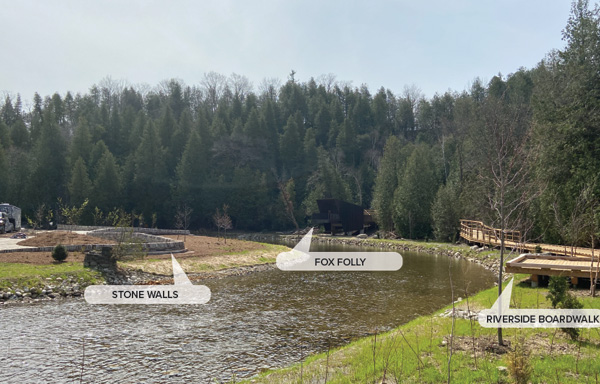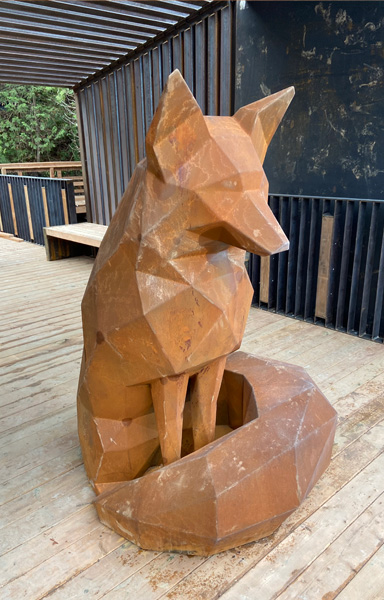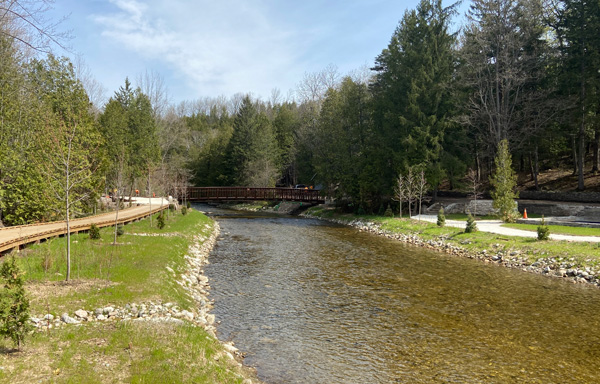BELFOUNTAIN CONSERVATION AREA HERITAGE & REVITALIZATION
Belfountain Conservation Area in Belfountain, is a historic and scenic jewel with a long history. It is also undergoing big changes being undertaken by Credit Valley Conservation.
Located in the heart of the Niagara Escarpment, the Belfountain Conservation Area (also known affectionately as “Mack’s Park”) sits on the eastern edge of the cozy hamlet of Belfountain and the Park and was designated by the Town of Caledon as a heritage property in December 2020.

What is its Heritage?
Mack’s Park takes its nickname from its founder. Few people know the rubber stamp was invented in Toronto by Charles Wilson Mack (1858-1942)! In 1909 the property was bought by Mack with the idea of it being a private respite for the ailing businessman. Called “Luckenuf”, it was envisioned as a public park built in the English Picturesque style, popular on estates in Canada since the 1790s, and opened to the public in 1914. This style was also popular in England during the late 18th Century, influenced by painters working in the Italian countryside such as Poussin, Lorrain, and Salvatore Rosa. Its goal as applied to English estates was to capture the painting style in the third dimension by modifying nature in order to organize the physical elements as they would be portrayed in a painting, while retaining the site’s naturalness.
Both Mack and his wife, Addie Madella Mack, shared a dream founded in religious belief and expressed through community service that parks, the study of nature, and gardening were a means of combatting social ills. These beliefs were extremely popular among the elite in the Edwardian and Interwar periods. They picked the picturesque river valley site in Belfountain to develop their dreams.
For three decades, the Macks built their dream by employing the services of Belfountain resident Samuel Weston Brock (1873-1944). Beginning in 1910, Mack employed Brock for six months out of the year in a variety of capacities including overseeing mining, dam building, masonry and statue projects, plumbing, and garden layout and upkeep, among others. According to the report to the Heritage Committee, “Brock sustained a high degree of craftmanship and artistry over three decades of work, and in the construction of the park’s grotto in 1928 he demonstrated great technical ability. It is a remarkable achievement for vernacular construction.”
The Park also turned the sleepy hamlet of Belfountain into a summer resort, by attracting day visitors, artists, writers, musicians, teachers and prominent Torontonians who cottaged there. In 1959 it was acquired by the newly formed Credit Valley Conservation Authority, after having been run as a private park since Mack’s death in 1942.
21st Century Revitalization
What does this “remarkable achievement” look like, and what does the revitalization project propose? The Belfountain Conservation Area Management Plan approved by the Town and Heritage Caledon looks to a 25-year plan “that balances and celebrates the property’s unique cultural heritage, environmental features and visitor and community enjoyment.” Anyone familiar with Belfountain knows of the scenic valley slopes to the east side of the town that dips down to the West Credit River, running through a dramatic landscape on this part of the famous Niagara Escarpment.

While the Belfountain Dam, built by Mack in 1910 and modified by CVC in the 1960s, provides a spectacular waterfall feature for visitors, one of the unfortunate environmental legacies of the headpond behind the dam has been in its impact on water quality, sediment accumulation, and fish habitat. The first phase of the park restoration work included modifying the dam by lowering its water height by one metre and removing the sluiceway, which allows for a new and more natural channel for the West Credit River. This change also sees the dam return to its original width while preserving the drama and excitement of the waterfall and continuing its protection of the sensitive Brook Trout population upstream.

After the new channel was established, construction of the Heritage Gardens commenced. This new area of public realm pays homage to the English Picturesque style and includes new meandering low stone walls made of locally sourced Credit Valley Sandstone (original to the area) and crafted by dry stone masonry experts. It also includes extensive planting of native species designed to beautify the gardens, provide riparian habitat and enhance the stability of the river channel. New pathways and elevated boardwalks along the south slope of the former pond will now provide visitors with safer access- ibility and views to the riverside and forest areas. An interesting and new addition to the landscape includes a modern ‘folly’ structure, to be named “Fox Folly” which hosts a geometric sculpture of Lucky the Fox which overlooks the river valley.

What remains of “Mack’s Park” are the specially-commissioned stone and concrete works such as a tiered fountain, retaining walls, circular oven, terraces, hillside steps, and the grotto. These, as well as the restoration of the original concrete walls, and the conversion of the swimming pool enclosure into a lily pond, a suspension bridge, will be renovated to display the original brilliance of Mack’s vision and Brock’s work for a new generation. The old concrete bridge that formerly constrained the river at the backwater of the Headpond has now been replaced with a new arch-span pedestrian bridge that accommodates the new river channel. The bridge has been custom designed to react to the design style of the Heritage Gardens while also simultaneously allowing for flood and vessel passage underneath.

“Mack’s Park” in Today’s World
Charles and Addie Mack began a tradition of attracting Toronto’s artistic and literary sets to Belfountain and Caledon by extension, and it’s a trend that continues to this day. However, these days, the roads of the “sleepy hamlet” are jam-packed with tourists in summer, all looking to take advantage of the wonderful scenery on offer, much as they did a hundred years ago.
This is why the current project to rebuild and refurnish this much-beloved vision takes on the same importance as the original construction over a century ago. Perhaps in this era of urban sprawl and heavy development, there is something to be said about Credit Valley Conservation’s continuing belief in Mack’s vision and the restoration and reinvigoration of that dream. Opening for the summer of 2022, it will serve the public’s needs for generations to come.
WRITTEN BY: KIRA DORWARD | RESOURCES: CREDIT VALLEY CONSERVATION

